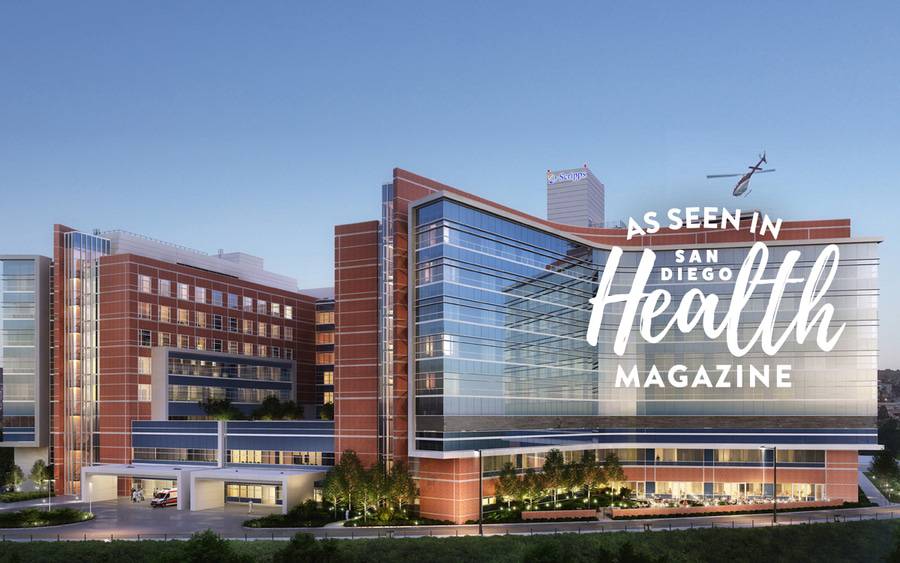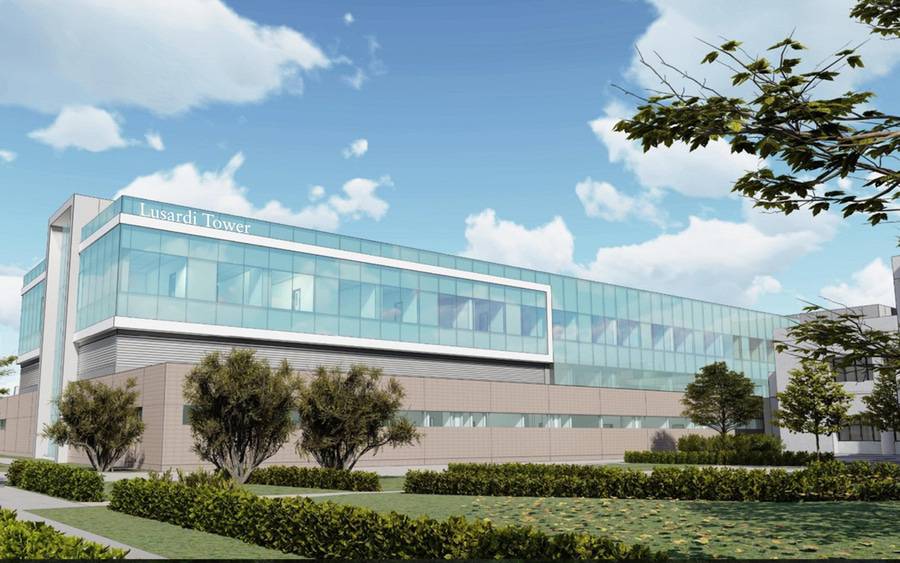Investing in Tomorrow’s Health Care Needs
Investing in Tomorrow’s Health Care Needs
How you can support Scripps’ legacy of caring for San Diego
As Scripps approaches its 100th anniversary in 2024, people throughout the organization are asking a series of questions.
What does the next 100 years look like? How do we keep pace with medical technology and the latest digital advancements? What kinds of facilities and services will Scripps hospitals and clinics need to provide? How do we expand these capabilities, increase quality, improve the patient experience and provide outstanding care?
One of the first steps is to develop the right infrastructure, throughout the system, to meet the needs of our growing community — and then go a few steps beyond.
“We’re going to give San Diego the state-of-the-art health care it deserves,” says John Engle, Scripps corporate senior vice president and chief development officer. “You won’t have to leave town, or your part of the city, to find it. Great care will be right here when you need it.”

An essential expansion at Scripps Memorial Hospital La Jolla
Even after the Prebys Cardiovascular Institute opened in 2015, Scripps Memorial Hospital La Jolla needed more space to care for patients. More recently, the COVID-19 pandemic has underscored the need for clinical flexibility, so providers can easily pivot to meet each patient’s personalized needs.
To provide excellent care — for patients now and decades from now — Scripps is continuing its master plan by building a 433,000-square-foot hospital on the La Jolla campus. The new tower will have private patient rooms; surgical, imaging and interventional radiology suites; and the flexibility to adjust to community needs and add new technologies as they become available and will fit seamlessly into the campus. Additional build-out of the campus is also planned in the next decade.
“The new tower will mirror the Prebys Cardiovascular Institute design, and the two will be attached to make it easy to move back and forth,” says Dale Mitchell, MD, a Scripps Clinic OB-GYN and Scripps La Jolla chief of staff. “That will provide easy access between inpatient facilities, the emergency department, imaging, surgery and outpatient care as well.”
The new tower will also house a revamped women’s center with 38 private rooms, 13 labor and delivery rooms, and a NICU, run in collaboration with Rady Children’s Hospital, with 10 private beds. A 150,000 square-foot medical pavilion will provide additional space for outpatient care, including an ambulatory surgical center and birth center.
“These facilities are designed to be tremendously flexible,” Dr. Mitchell says. “We don’t know exactly what San Diego’s health care needs will be in 20 years, but we want to create facilities that can be modified to meet future health care needs.”
*This article was published prior to Prebys Cancer Center’s opening on September 13, 2021.
“We’re going to give San Diego the state-of-the-art health care it deserves. You won’t have to leave town, or your part of the city, to find it. Great care will be right here when you need it.” — John Engle
Critical, convenient cancer care at Scripps Mercy Hospital
In August 2019, Scripps began building Prebys Cancer Center at Scripps Mercy Hospital San Diego. Part of Scripps Cancer Center, the comprehensive facility will open in 2021. The center will include multidisciplinary suites, physician collaboration spaces, a chemotherapy/immune therapy infusion suite and radiation therapy with the most advanced TrueBeam linear accelerators available.
“This will be the first time we’ve been able to offer radiation therapy at Scripps Mercy Hospital,” says Scripps Clinic and Scripps Cancer Center medical oncologist Marin Xavier, MD. “As a result, we won’t need to transfer people to facilities in other parts of the county. Patients often receive radiation therapy every day for six weeks, which is a lot of driving. So having a facility close to home is really important.”
The new facility will also make it easier for providers in multidisciplinary care teams. These teams are customized for each patient and can include medical, radiation, surgical, gynecologic and genitourinary oncologists; a pathologist, a radiologist and other specialists. They review each case and, working with patients and families, develop precise, personalized care plans. Patients can meet with all of their specialists during a single appointment, which eases the logistical burden and enhances coordination.

“In addition to medical, radiation and surgical oncology, we will have subspecialty surgeons in gynecologic, genitourinary and thoracic oncology,” says Dr. Xavier. “Multidisciplinary clinics and tumor conferences will include advanced endoscopists in gastroenterology and pulmonology, hepatologists and a whole palliative care team, including an interventional pain specialist. Scripps Cancer Center radiology and pathology will be integrated into the treatment planning conferences.”
In addition, the newly renovated Woltman Family College Building at Scripps Mercy San Diego will provide supportive services for patients and families. Once renovated, it will offer spiritual and palliative care, integrative medicine, cancer patient support, graduate medical education and other services.
A medical pavilion is expected to open in 2025, offering primary care and extensive specialty care services. A new hospital tower will tie everything together. Built adjacent to the existing hospital and the Conrad Prebys Emergency and Trauma Center, the new tower will include around 350 private rooms, an intensive care unit, and radiological and surgical suites.
“Central San Diego, South Bay and East County are expanding rapidly, and we must provide the best care for these growing communities,” Engle says. “Prebys Cancer Center, Woltman Family College Building and the new hospital tower will ensure we can recruit the best physicians and bring in the most sophisticated medical technologies to provide that high level of care.”
Enhanced state-of-the-art services at Scripps Memorial Hospital Encinitas
Scripps Memorial Hospital Encinitas has been a North County cornerstone for more than 50 years, offering emergency services, intensive care, a Level II neonatal nursery, comprehensive rehabilitation, cancer care and North County’s first certified primary stroke center.
But the region is growing fast, and Scripps must keep up.
“When I started at Encinitas in 1986, the hospital had 78 inpatient beds and six ER beds,” says pulmonologist Scott Eisman, MD. “Now we have 36 ER beds and we’re usually full. It’s important that we build these services out so we can be there for our community.”

A generous donation from Warner and Debbie Lusardi will help fund the Lusardi Tower, a new 224,000-square-foot hospital building that will provide 64 private inpatient rooms, surgical suites, intensive care and other facilities. Equipped with the latest wireless technologies, flexible surgical suites, advanced digital monitoring and telemedicine capabilities, the facility is designed to restore health as quickly as possible.
Scripps Encinitas is also creating a hub to focus on pulmonary care with the Lusardi Pulmonary Institute, plus a new medical office pavilion to provide clinic space for Scripps Cancer Center and other specialties.
“Scripps Memorial Hospital Encinitas has seen a 30-percent growth during the last several years,” says Scripps president and CEO Chris Van Gorder. “So the beds, the new tower and the state-of-the-art facility are really needed right now.”
Philanthropic gift will propel pulmonary care
Philanthropy will help expand on Scripps Encinitas’ existing pulmonary expertise, with clinicians caring for patients with lung cancer, COPD, COVID-19, sleep disorders and other conditions.
“We know that if we catch lung cancer early, we’re more likely to cure it,” says Dr. Eisman. “We also want to advance treatment for chronic lung diseases, such as emphysema and pulmonary fibrosis, and conduct research to improve care. All these aspects will advance with the new Lusardi Pulmonary Institute.”
The Lusardi Pulmonary Institute will enhance research on new treatments, pulmonary rehabilitation, robotic diagnostics and many other approaches, improving care for people worldwide.
“The Lusardis have made a legacy gift, much like Ellen Browning Scripps and Conrad Prebys,” says Dr. Eisman. “It’s not just about the building; it’s about the work that goes on in the building, both in the near future and for generations to come.”
This content appeared in San Diego Health, a publication in partnership between Scripps and San Diego Magazine that celebrates the healthy spirit of San Diego.